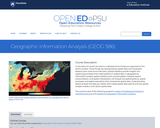
In this data rich world, we need to understand how things are organized on the Earth's surface. Those things are represented by spatial data and necessarily depend upon what surrounds them. Spatial statistics provide insights into explaining processes that create patterns in spatial data. In geographical information analysis, spatial statistics such as point pattern analysis, spatial autocorrelation, and spatial interpolation will analyze the spatial patterns, spatial processes, and spatial association that characterize spatial data. Understanding spatial analysis will help you realize what makes spatial data special and why spatial analysis reveals a truth about spatial data.
- Subject:
- Applied Science
- Computer Science
- Information Science
- Physical Geography
- Physical Science
- Material Type:
- Full Course
- Provider:
- Penn State College of Earth and Mineral Sciences
- Author:
- David O'Sullivan
- Date Added:
- 10/07/2019
